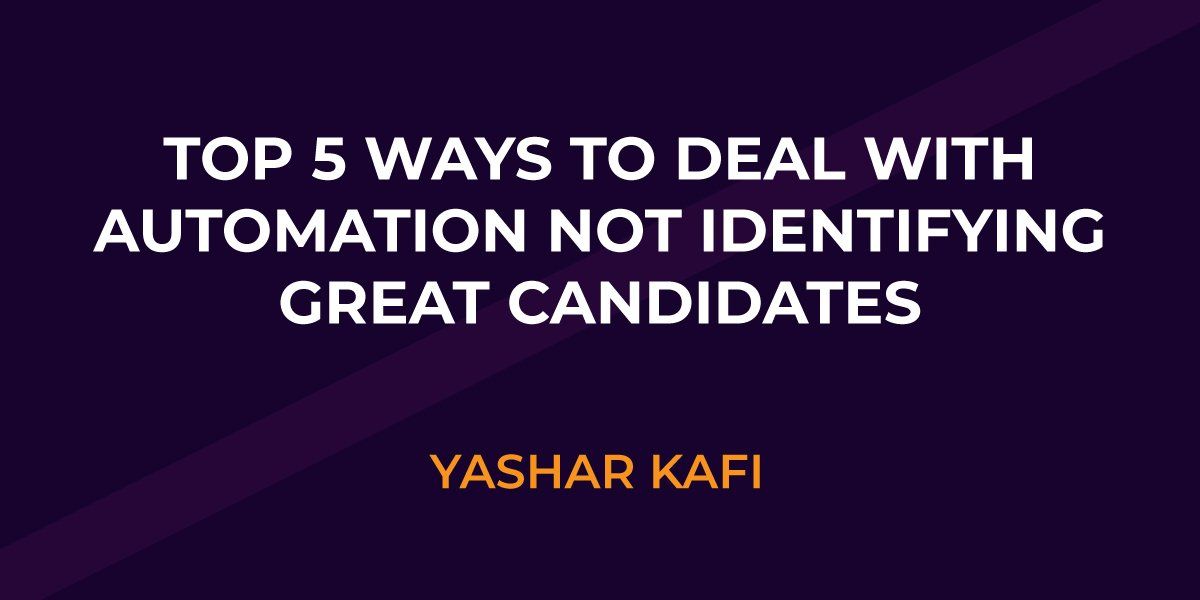Top 5 Ways to Deal With Automation Not Identifying Great Candidates
Yashar Kafi
The majority of organizations and middleman job-boards use industry-leading recruitment automation programs and software rather than manually sifting through individual résumés. Applicant tracking systems have gained more features over time, and they are now being augmented with other automation capabilities to make the process even more efficient.
The question we are left with is this: does the effectiveness of this process extend to applicants the way it does the recruiters looking to fill positions? The answer is, not yet. Algorithms aren’t quite as capable as humans at applying the subjectivity required to select the best candidate for a role.
Bridging The Gap
Here are five ways human recruiters can bridge the gap between automation and applicants during the recruitment process.
Personalized Communication
Once a potential candidate has submitted a résumé to your organization, it pays dividends to go beyond an automated email that says, “thank you for your application…” It is far more appealing and encouraging for applicants when they see a slightly longer email, one that assures them that a member of your staff will be reviewing their application in the coming days. Even better, provide them with access to a portal that allows them to follow the progress of their application.
Transparency Throughout
The modern workforce expects transparency, in the workplace and in the recruitment and application process. The previously mentioned concept of a recruitment portal is already found within top organizations today. Keep in mind that organizations are always looking to provide their customers with a seamless, smooth experience, and, in many ways, a prospective employee is a customer too.
They should have a good experience during the hiring and recruiting process. This is the organization’s opportunity to show that they are a worthy employer ─ an increasingly relevant factor in today’s competitive job market.
Don’t Ghost Talent
Some talented candidates just aren’t ready to work for your organization ─ their skill set might not fit the bill, or their experience might not be perfectly matched to your needs. Automated systems may simply remove these candidates from the ‘potential’ pile. An organization could be unintentionally destroying potential future relations with a to-be expert in a field that might benefit them in the future.
Instead of simply ignoring or ‘ghosting’ the candidate, staff should monitor who is removed from the potential candidates list. Hidden gems can therefore be nurtured for future opportunities.
User Network Connection
Organizations should ensure that hiring managers and key recruitment process employees are present on networking sites like LinkedIn. These websites and apps are an excellent way for talent to connect with a relevant member of an organization’s workforce to make sure that they are noticed ahead of potential algorithm annihilation.
Use The Best
If you are outsourcing your recruitment process to a third-party, use common sense to screen and select a partner. The better their reputation and statistics, the more effective they will be on your behalf. Aim to use recruiting partners over staffing firms, and make sure that you find the perfect one for your organization ahead of any recruitment drive. The better the recruiter, the better the candidates that arrive at your desk.
Recruitment automation tools have revolutionized the industry over the last couple of decades. They bring with them an opportunity for recruiters and consultants to streamline the whole process, bettering the experience for themselves, the client, and the applicants. That said, it is important to remember that new software, shiny though it may be, isn’t perfect. Any mistakes could cost your organization an all-star candidate simply because they didn’t include the right key-word on their application.




